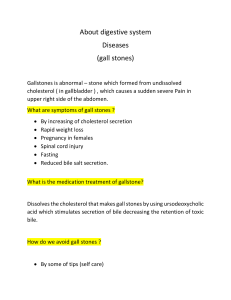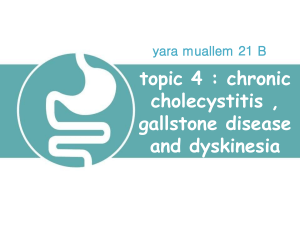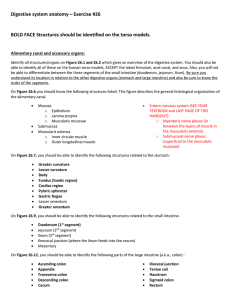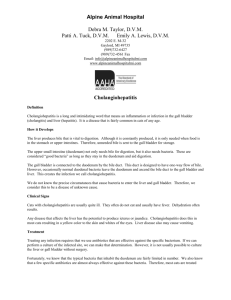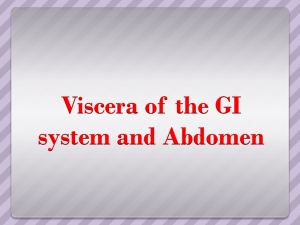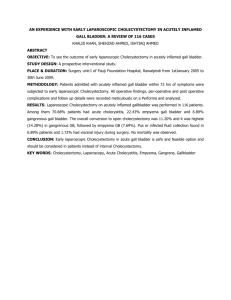CHOLECYSTITIS Bernard M. Jaffe, M.D. Professor of Surgery, Emeritus
advertisement
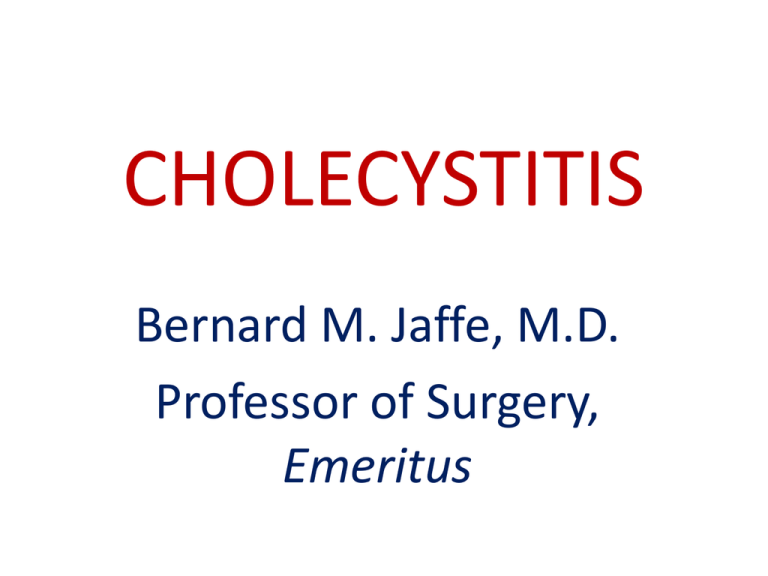
CHOLECYSTITIS Bernard M. Jaffe, M.D. Professor of Surgery, Emeritus GALLBLADDER • • • • • • • Major Function- Concentrate, Store Bile Supplied by Cystic Artery Off Right Hepatic Artery Off Common Hepatic Artery Off Celiac Trunk Many Arterial Variations Replaced Right Hepatic Takes Off From Superior Mesenteric DUCTS • • • • • • • • Right and Left Hepatic Ducts Join ↓ Common Hepatic Duct Cystic Duct Comes Off ↓ Common Bile Duct ↓ Ampulla, Duodenum GALLSTONES • Autopsy Prevalence 11-36% • Female:Male Ratio is 3:1 • First Degree Relatives Have Twice the Rate • Cholecystectomy One of Commonest Operations PREDISPOSING FACTORS • • • • • • Obesity Pregnancy Dietary Factors Crohn’s Disease, Ileal Resection Hemolytic Diseases Gastric Surgery GALLSTONE CONSTITUENTS • • • • • Bilirubin Bile Salts Phospholipids Cholesterol Calcium CHOLESTEROL STONES • • • • • • • Most Common Type Rarely Pure, >70% Cholesterol Precipitation from Supersaturated Bile Usually Multiple, Variable Sizes Hard and Facetted to Irregular and Soft Color White/Yellow to Brown/Black Only 10% are Radio-opaque PIGMENT STONES • • • • • • <20% Cholesterol Dark Because of Calcium Bilirubinate Usually Tiny to Small Invariably Multiple Two Types- Black Stones Brown Stones BLACK STONES • • • • • • • Form ONLY in Gall Bladder Secondary to Hematologic Diseases Spherocytosis Sickle Cell Disease Thalassemia Common in Cirrhosis More Common in Asia BROWN STONES • Form in Gall Bladder AND Bile Ducts • Small, Soft, Often Mushy • Secondary to Bacterial Infection Caused by Bile Stasis • Bacterial Cell Walls Prominent in Stones • More Common in Asia NATURAL HISTORY • Most Are Asymptomatic • Asymptomatic Stones Detected On Evaluation For Other Illnesses • Ultrasound • CT • Plain Abdominal X-Ray • Laparotomy • 2/3 Stay Asymptomatic >20 Years • COMPLICATIONS • • • • • • • Biliary Colic- Initial Symptom Acute Cholecystitis Choledocholithasis Cholangitis Biliary Pancreatitis Cholecysto-Duodenal Fistula Gall Bladder Carcinoma CHOLECYSTECTOMY • Indicated for Symptomatic Patients • Rare Indications in Asymptomatic Ones • Elderly Diabetics • Before Transplantation • Isolation From Medical Care • Gallbladder Polyp (Controversial) • Porcelain Gall Bladder Absolute Indication CHRONIC CHOLECYSTITIS • Recurrent Attacks of Pain • Frequently After a Meal (Fatty?) • Radiates to Back and Shoulder • Nausea and Vomiting • Gall Bladder- Minor Inflammation to Small, Shrunken With Fibrosis, Adhesions • Mucosa Becomes Atrophied DIAGNOSIS • Stones on Ultrasound • Gall Bladder May Have Sludge • Cholesterolosis- Strawberry Gall Bladder • Adenomyomatosis- Thick Wall • Normal Ducts • Cholecystectomy Cures >95% ACUTE CHOLECYSTITIS • Obstruction of Cystic Duct By Stone • Gall Bladder Distention, Inflammation, Edema • Mucus Secretion- Hydrops, Milk of Bile (Pearly White) • 5-10% Progress to Ischemia, Necrosis • Perforation Occurs in Body (Widest Part) MANIFESTATIONS • • • • • • • Biliary Colic → Lasting, Constant Pain Anorexia, Nausea, Vomiting, Fever Focal RUQ Tenderness, Guarding Murphys’ Sign is Suggestive Palpable Gall Bladder is Diagnostic Normal LFTs, ?Minimal Bilirubin Elevation White Blood Cell Count Often Elevated DIAGNOSIS • Ultrasound • Stones • Thickened Gall Bladder Wall • Distended Gall Bladder • Peri-Cholecystic Fluid • Sonographic Murphy’s Sign • If HIDA Scan Fills Gall Bladder- Precludes Diagnosis TREATMENT • Antibiotics- Gram Negative and Anaerobic Coverage • Early laparoscopic Cholecystectomy • Late Presentation >4-5 DaysAntibiotics Alone with Delayed Cholecystectomy • Very Ill, Elderly patients- Percutaneous Cholecystostomy LAP CHOLE • Mortality 0.1%, Morbidity 0.3% • Can Add Choledochotomy • Conversion to Open in Acute Disease Reasons for Conversion • Inability to Visualize Adhesions • Duct Injury Bleeding • Abnormal Anatomy CHOLEDOCHOLITHIASIS • Primary Stones Form in Ducts • Associated with Biliary Dysfunction, Infection • Brown Stones • Secondary Stones Form in Gall Bladder • Migrate to Common Bile Duct • 6-12% Cholelithiasis Patients • 20-25% in Patients >60 MANIFESTATIONS • Symptomatic or Can Be Silent • Colicky Pain, Nausea, Vomiting, ICTERUS • Stones Single or Multiple, Small or Large • Can Cause Common Duct Obstruction • Cholangitis • Biliary Pancreatitis DIAGNOSIS • Elevated Bilirubin, Alkaline Phosphatase, Transaminases • Ultrasound- Dilated Ducts • Magnetic Resonance CholangiogramSensitivity 95%, Specificity 89% • ERCP- Successful >90%, Morbidity <5% • Therapeutic and Diagnostic TREATMENT • ERCP With Sphincterotomy • Common Bile Duct Exploration • Open or Laparoscopic • T-Tube Left in Place • Missed Stones Can Be Retrieved Choledochoscope CHOLANGITIS • Ascending Infection Associated With Bile Duct Obstruction • Commonest Organisms • E. coli • Klebsiella • Strep faecalis • Bacteroides • 5-10% Mortality MANIFESTATIONS • Charcot’s Triad • Abdominal Pain • Jaundice • Fever • Reynold’s Pentad • Same Plus Septic Shock • Mental Status Changes TREATMENT • Immediate Antibiotics, Resuscitation • Duct Drainage (Cholangitis is Closed Space Infection) • ERCP With Sphincterotomy • Percutaneous Transhepatic Cholangiogram With Catheter Placement • Open Common Duct Exploration
